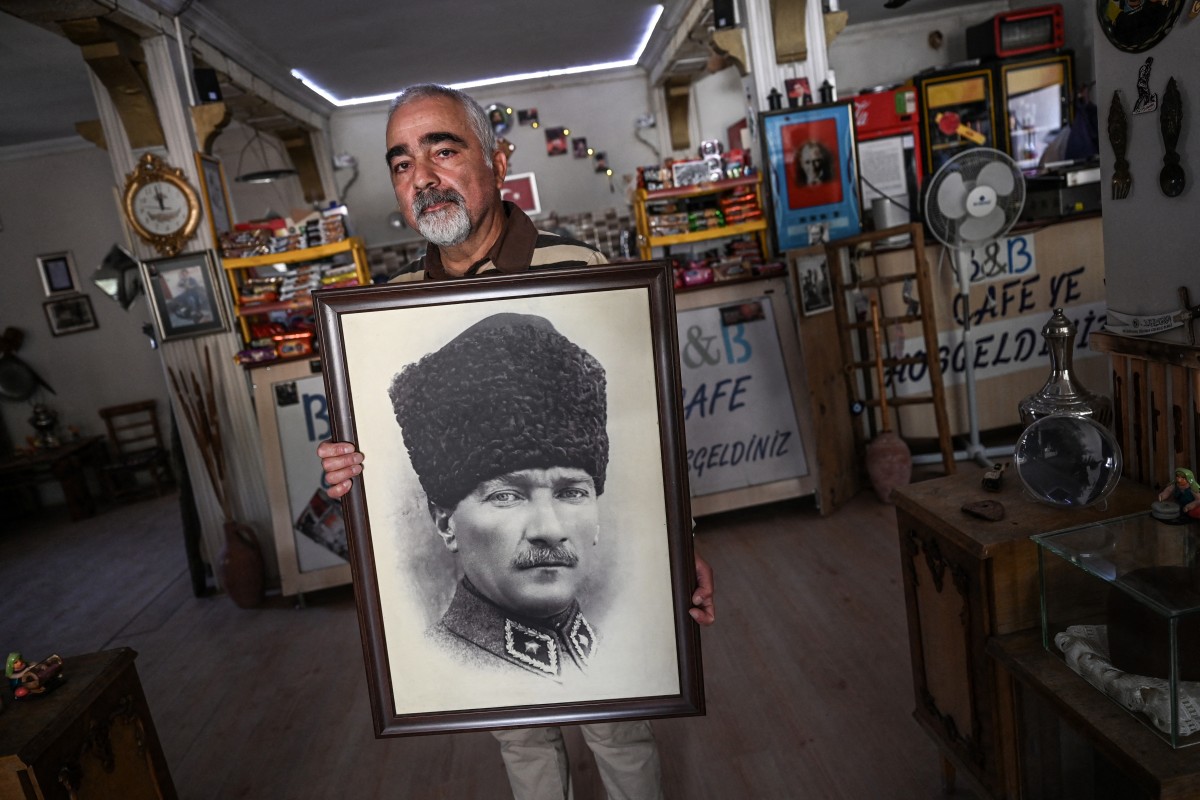Kemaliye, Turkey – Standing at the foot of the cliff overlooking Kemaliye, the golden statue of Mustafa Kemal Ataturk, the father of the nation, evokes the glorious past of this small town in eastern Turkey.
Ataturk rewarded the loyalty of the town, nestled between the mountains and the sources of the Euphrates, by giving it his name ahead of creating the Turkish republic out of the ashes of the Ottoman Empire 100 years ago.
“The whole country would have wanted to bear his name but he would never have accepted!” said retired hotelier Haci Omer Yalcinkayalar, referring to the modest nature of Ataturk, who will be celebrated on the nation’s anniversary on October 29.
General Mustafa Kemal, hero of the Dardanelles war against the Allies, in 1919 began confronting the Westerners who occupied the dismembered empire to found the independent nation he longed for.
His forces found themselves nearing disaster at the gates of Ankara in 1921 when he received a telegram from Egin, a trading town at the crossroads of Anatolia and the Caucasus, with an Armenian population.
The telegram read: “Dear Pasha, we have 500 horsemen ready to leave at your command,” recounted Yalcinkayalar.
Situated on the caravan routes heading towards Baghdad, Iran and Georgia, the town was prosperous.
This is evidenced by the persisting stone and wooden houses that were built along the steep slopes of the mountainside, which town authorities requested to be classified as a UNESCO world heritage site.
The entire district had around 20,000 inhabitants including some 6,000 in Kemaliye itself in Ataturk’s time, compared with 1,500 residents today.
“In the end, they didn’t have to do it,” Yalcinkayalar said of the offer to send horsemen.
But Ataturk did not forget the gesture and, a year later, he wrote to the Egin municipal council to offer his name.
“It was given to us as a gift,” said the 73-year-old who has devoted his retirement to his town’s history. “It honours us: with the republic, we joined the civilised world.”
‘Very special love’
At the foot of the statue, a sign reads: “To thank the district for the support it gave for the national independence, its name is changed from Egin to Kemaliye.”
Kemaliye has been home to many celebrations including concerts, football tournaments and banquets on every October 29 since the birth of the republic in 1923.
In Guzide Tufekci’s family, the story is passed down with enthusiasm: the 60-year-old former literature professor, an enthusiastic Kemalist, recalled what Turkish women owe to Ataturk and the republic.
“He opened the way for enlightened Turkish women, intellectuals, to have access to education, to have a profession. We’re proud of him,” she said.
Facing a small train station that has served Kemaliye since 1938, a modest cafe is decorated like a museum.
Erdal Erdurk, 59, has hung portraits of Ataturk on all the walls — in colour, in black and white, in a soldier’s uniform, in a tuxedo or wearing his Astrakhan hat — and hung a huge red flag bearing his image above the entrance.
After vigorously cleaning the dust off one of the frames, which he kissed before hanging, Erdurk spoke of “the very special love of the town for Ataturk”.
“He is our protector. He founded our country, our republic: all these portraits that you see here, are just talking about them, it moves me,” he said.
Yet the town itself refrains from displaying its history: its streets are barely decorated and only a few windows reveal the portrait of the celebrated man.
Sevket Gultekin, 62, a taxi driver and singer, holds the key to a small museum that is the most decorated.
Tourists who visit the region mainly come to admire the “Dark Canyon”, one of the five deepest in the world, according to UNESCO. It is often only upon arriving in Kemaliye that they discover its past.
“When our guide taught us, it made us happy,” said Haluk Mutluay, 58, from the coastal city of Mersin, in southern Turkey.
“Ataturk means a lot to us, he’s our father.”
From the Ottoman Empire to the Turkish Republic: key dates
The Republic of Turkey, founded on October 29, 1923, which celebrates its centenary Sunday, was born out of the ashes of the Ottoman Empire and vision of Mustafa Kemal Ataturk who became its first president.
Here are the key dates of its transition.
1918: Dismantling the Empire
Allied with the losers of the First World War – Germany, Austria-Hungary and Bulgaria – the Ottoman Empire which stretched from the Balkans to present-day Yemen is dismantled by the victors: Italy, France and the United Kingdom.
They share out the former Empire’s provinces, except Istanbul, and give themselves “zones of influence”.
1919: Nationalist movement
A growing nationalist movement is led by the young General Mustafa Kemal, who had distinguished himself against the Allies in the Dardanelles Strait.
He launches a war of independence against the occupiers.
1920: Treaty of Sevres
The Treaty defines the borders of Turkey, contested by nationalists who wanted to recover part of the lost territories, including Thrace and west of the Aegean ceded to Greece.
1922: End of the Sultanate
On November 1, 1922: the sultanate, installed at the end of the Empire, is abolished.
1923: Treaty of Lausanne
The Treaty is signed On July 24, 1923 by the United Kingdom, France, Italy, Japan, Greece and Yugoslavia, and nullifies the Treaty of Sevres and redefines the borders of Turkey.
It also renounces the creation of Turkish Kurdistan.
October 29, 1923: Republic proclaimed
The Republic of Turkey is officially proclaimed and Mustafa Kemal is elected president.
In 1934, the Turkish Assembly grants him the name “Ataturk”, meaning the “father of the Turks.”

